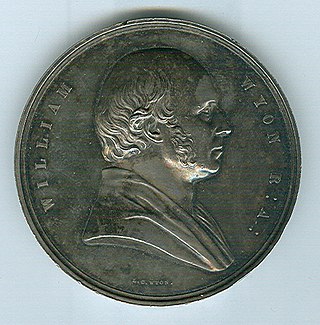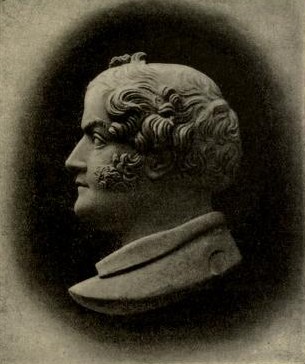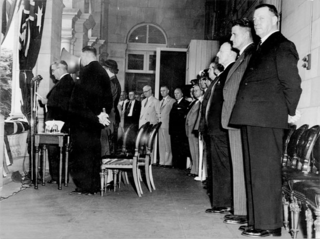
The penny of Great Britain and the United Kingdom from 1714 to 1901, the period in which the House of Hanover reigned, saw the transformation of the penny from a little-used small silver coin to the bronze piece recognisable to modern-day Britons. All bear the portrait of the monarch on the obverse; copper and bronze pennies have a depiction of Britannia, the female personification of Britain, on the reverse.

William Wyon, was official chief engraver at the Royal Mint from 1828 until his death.

Benedetto Pistrucci was an Italian gem-engraver, medallist and a coin engraver, probably best known for his Saint George and the Dragon design for the British sovereign coin. Pistrucci was commissioned by the British government to create the large Waterloo Medal, a project which took him thirty years to complete.

In the United Kingdom, the Accession Council is a ceremonial body which assembles in St James's Palace in London upon the death of a monarch to make formal proclamation of the accession of the successor to the throne. Under the terms of the Act of Settlement 1701, a new monarch succeeds automatically. The proclamation confirms by name the identity of the new monarch, expresses loyalty to the "lawful and rightful Liege Lord", and formally announces the new monarch's regnal name, while the monarch and others, in front of the council, sign and seal several documents concerning the accession. An Accession Council has confirmed every English monarch since James I in 1603.

The monarchy of New Zealand is the constitutional system of government in which a hereditary monarch is the sovereign and head of state of New Zealand. The current monarch, King Charles III, acceded to the throne following the death of his mother, Queen Elizabeth II, on 8 September 2022 in the United Kingdom. The King's elder son, William, Prince of Wales, is the heir apparent.

The Great Seal of the Realm is a seal that is used in the United Kingdom to symbolise the sovereign's approval of state documents. It is also known as the Great Seal of the United Kingdom. To make it, sealing wax is melted in a metal mould or matrix and impressed into a wax figure that is attached by cord or ribbon to documents that the monarch wishes to seal officially. The formal keeper of the seal is the Lord High Chancellor of Great Britain.
Thomas Wyon the Younger was an English medallist and chief engraver at the Royal Mint.

New Munster was an early original European name for the South Island of New Zealand, given by the Governor of New Zealand, Captain William Hobson, in honour of Munster, the Irish province in which he was born.

The Cook Islands are a constitutional monarchy within the Realm of New Zealand. Under the Cook Islands Constitution, the Sovereign in Right of New Zealand has been Head of State of the Cook Islands since 4 August 1965. The Sovereign is represented by the King's Representative; as such, the King is the de jure head of state, holding several powers that are his alone, while the King's Representative is sometimes referred to as the de facto head of state. The viceregal position is currently held by Tom Marsters.

Elizabeth II was proclaimed queen throughout the Commonwealth after her father, King George VI, died in the early hours of 6 February 1952, while Elizabeth was in Kenya. Proclamations were made in different Commonwealth realms on 6, 7, 8, and 11 February. The line of succession was identical in all the Commonwealth realms, but the royal title as proclaimed was not the same in all of them. Accession was followed sixteen months later by the Coronation of Elizabeth II at Westminster Abbey in London on 2 June 1953.

The New Zealand Constitution Act 1846 was an Act of the Parliament of the United Kingdom that was intended to grant self-government to the Colony of New Zealand, but was never fully implemented. The Act's long title was "An Act to make further Provision for the Government of the New Zealand Islands". It received royal assent on 28 August 1846.
George William de Saulles was a British medallist. He designed the obverse of coins of the United Kingdom and its colonies under Queen Victoria and King Edward VII.
The Public Seal of Hong Kong, formally known as Public Seal of the Hong Kong Special Administrative Region is the seal for certifying government documents and legislations of Hong Kong. It is held by the Chief Executive.

The Colony of New Zealand was a colony of the United Kingdom from 1841 to 1907. British authority was vested in a governor. The colony had three successive capitals: Okiato in 1841; Auckland from 1841 to 1865; and Wellington from 1865. Following the New Zealand Constitution Act 1852, the colony became a Crown colony with its first elected parliament in 1853. Responsible self-government was established in 1856 with the governor being required to act on the advice of his ministers. In 1907, the colony became the Dominion of New Zealand within the British Empire.

Benjamin Wyon was a British engraver of seals, and medallist.

Joseph Shepherd Wyon was a British medallist and seal-engraver.

The Letters Patent Constituting the Office of Governor-General of New Zealand is a royal decree and a part of the uncodified New Zealand constitution. Sometimes known as the Letters Patent 1983, the instrument has been amended twice since its original issue in 1983. The letters patent—essentially an open letter from Queen Elizabeth II that is a legal instrument—constitutes the office of governor-general as the monarch's representative in the Realm of New Zealand, vests executive authority in the governor-general, establishes the Executive Council to advise the governor-general, and makes provision for the exercise of the governor-general's powers should the office be vacant.

The Jubilee coinage or Jubilee head coinage are British coins with an obverse featuring a depiction of Queen Victoria by Joseph Edgar Boehm. The design was placed on the silver and gold circulating coinage beginning in 1887, and on the Maundy coinage beginning in 1888. The depiction of Victoria wearing a crown that was seen as too small was widely mocked, and was replaced in 1893. The series saw the entire issuance of the double florin (1887–1890) and, in 1888, the last issue for circulation of the groat, or fourpence piece, although it was intended for use in British Guiana. No bronze coins were struck with the Jubilee design.
Charles III became King of the United Kingdom and of 14 other Commonwealth realms upon the death of his mother, Elizabeth II, on 8 September 2022. Royal succession in the realms occurs immediately upon the death of the reigning monarch. The formal proclamation in Britain occurred on 10 September 2022, at 10:00 BST, the same day on which the Accession Council gathered at St James's Palace in London. The other realms, including most Canadian provinces and all Australian states, issued their own proclamations at times relative to their time zones, following meetings of the relevant privy or executive councils. While the line of succession is identical in all the Commonwealth realms, the royal title as proclaimed is not the same in all of them.













